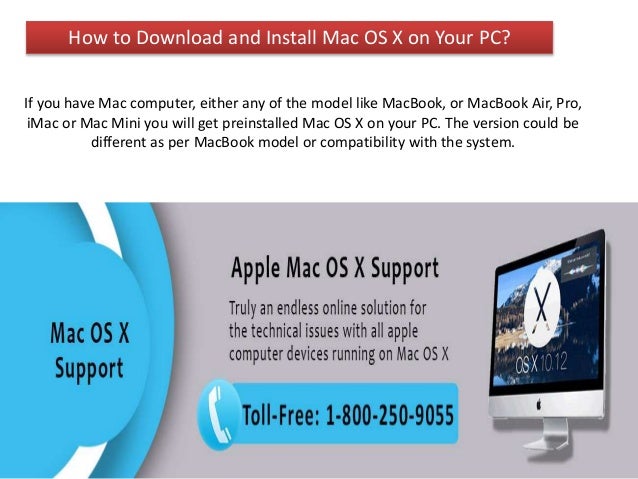The 'X' in Mac OS X and OS X is the Roman numeral for the number 10 and is pronounced as such. The core of macOS is an open source OS called Darwin, but Darwin itself cannot run macOS software. MacOS releases are named after kinds of big cats, or California landmarks, and have a version number that starts with 10. Make sure you are ready to downgrade your operating system by checking in with what version of OS X you already have and ensuring you have enough hard drive room to download the older version. Clicking the apple in the top left corner of your desktop and selecting About This Mac will allow you to see what OS X version you are currently running.
Mac OS X is Apple's operatingsystem for its line of Macintosh computers. Its interface, known asAqua, is built on a Unix foundation. Although ithas much of the look and feel of the former Mac OS,features such as preemptive multitasking, symmetric multiprocessing,multithreading, and protected memory give Mac OS X improved stabilityand performance. For the current version's system requirements, seeApple's Mac OS XTechnical Specifications.

Currently, four Mac OS X-related products are available:

Mac OS X: This is the version most Macintoshowners should use. It is a consumer operating system designed for useon your personal computer. For more information, see Apple's Mac OS X page and Developer page forMac OS X.
Mac OS X Server: This is Apple's server operatingsystem. It is similar to the consumer release of Mac OS X, but alsoincludes a suite of network services, such as a print server, filesharing, QuickTime streaming, NetBoot, and advanced webhosting. For more information, see Apple's Mac OS X Server page.
iOS: Based on Mac OS X, versions of iOS run on theiPhone, the iPod touch, and the iPad. The iOS was designed forhandheld devices, and is much more tightly controlled than otherversions of Mac OS X. Despite their shared origins, applications(apps) developed for iOS are not compatible with Mac OS X, and viceversa.

Mac Os X 10.8 Download Free
Darwin:Darwin is the Unix-likefoundation upon which Mac OS X is based. Its code is opensource, and it is available as a stand-alone operatingsystem. Although Darwin will run many Unix applications, including theX Window System, it does not have the Mac OS X interfaceand thus will not run Mac OS X applications. For more information, seeApple's Developer Open Sourcepage.
If you are on a Windows computer, see Install an older version of Adobe Reader | Windows.
Installing Adobe Reader is a two-step process. First you download the installation package, and then you install Adobe Reader from that package file.
Before you install, make sure that your system meets the minimum system requirements.
For Mac Os X
Note:
If you're running Mac OS X 10.9 or later, install the latest version of Reader. For step-by-step instructions, see Install Adobe Acrobat Reader DC on Mac OS.
Select your operating system, a language, and the version of Reader that you want to install. Then click Download now.
When asked whether to open or save the .dmg file, select Save File, and then click OK.
Important: If you do not see this dialog box, another window could be blocking it. Try moving any other windows out of the way.
Double-click the .dmg file. If you don't see the Downloads window, choose Tools > Downloads.
If the download package doesn't appear in the Downloads window and a Thank You screen remains visible, click the download link on the Thank You screen.
Double-click the Adobe Reader [version] Installer.pkg to start the installation.
If a dialog box appears telling you to quit Reader, close Reader, and then click OK.
When the Install Adobe Reader dialog box appears, click Continue. Follow the onscreen instructions to install Reader.
Versions For Mac Os X64
Note:
If you're running Mac OS X 10.9 or later, install the latest version of Reader. For step-by-step instructions, see Install Adobe Acrobat Reader DC on Mac OS.
Select your operating system, a language, and the version of Reader that you want to install. Then click Download now.
If a dialog box appears telling you to quit Reader, close Reader, and then click OK.
When the Install Adobe Reader [version] dialog box appears, click Continue. Follow the onscreen instructions to install Reader.
When the Install Succeeded window appears, click Close.

Currently, four Mac OS X-related products are available:
Mac OS X: This is the version most Macintoshowners should use. It is a consumer operating system designed for useon your personal computer. For more information, see Apple's Mac OS X page and Developer page forMac OS X.
Mac OS X Server: This is Apple's server operatingsystem. It is similar to the consumer release of Mac OS X, but alsoincludes a suite of network services, such as a print server, filesharing, QuickTime streaming, NetBoot, and advanced webhosting. For more information, see Apple's Mac OS X Server page.
iOS: Based on Mac OS X, versions of iOS run on theiPhone, the iPod touch, and the iPad. The iOS was designed forhandheld devices, and is much more tightly controlled than otherversions of Mac OS X. Despite their shared origins, applications(apps) developed for iOS are not compatible with Mac OS X, and viceversa.
Mac Os X 10.8 Download Free
Darwin:Darwin is the Unix-likefoundation upon which Mac OS X is based. Its code is opensource, and it is available as a stand-alone operatingsystem. Although Darwin will run many Unix applications, including theX Window System, it does not have the Mac OS X interfaceand thus will not run Mac OS X applications. For more information, seeApple's Developer Open Sourcepage.
If you are on a Windows computer, see Install an older version of Adobe Reader | Windows.
Installing Adobe Reader is a two-step process. First you download the installation package, and then you install Adobe Reader from that package file.
Before you install, make sure that your system meets the minimum system requirements.
For Mac Os X
Note:
If you're running Mac OS X 10.9 or later, install the latest version of Reader. For step-by-step instructions, see Install Adobe Acrobat Reader DC on Mac OS.
Select your operating system, a language, and the version of Reader that you want to install. Then click Download now.
When asked whether to open or save the .dmg file, select Save File, and then click OK.
Important: If you do not see this dialog box, another window could be blocking it. Try moving any other windows out of the way.
Double-click the .dmg file. If you don't see the Downloads window, choose Tools > Downloads.
If the download package doesn't appear in the Downloads window and a Thank You screen remains visible, click the download link on the Thank You screen.
Double-click the Adobe Reader [version] Installer.pkg to start the installation.
If a dialog box appears telling you to quit Reader, close Reader, and then click OK.
When the Install Adobe Reader dialog box appears, click Continue. Follow the onscreen instructions to install Reader.
Versions For Mac Os X64
Note:
If you're running Mac OS X 10.9 or later, install the latest version of Reader. For step-by-step instructions, see Install Adobe Acrobat Reader DC on Mac OS.
Select your operating system, a language, and the version of Reader that you want to install. Then click Download now.
If a dialog box appears telling you to quit Reader, close Reader, and then click OK.
When the Install Adobe Reader [version] dialog box appears, click Continue. Follow the onscreen instructions to install Reader.
When the Install Succeeded window appears, click Close.
Newest Mac Os
To see if other users are experiencing similar download and installation problems, visit the Acrobat Reader forum, or the Deployment & Installation forum on AcrobatUsers.com. Try posting your problem on the forums for interactive troubleshooting. When posting on forums, include your operating system and product version number.
